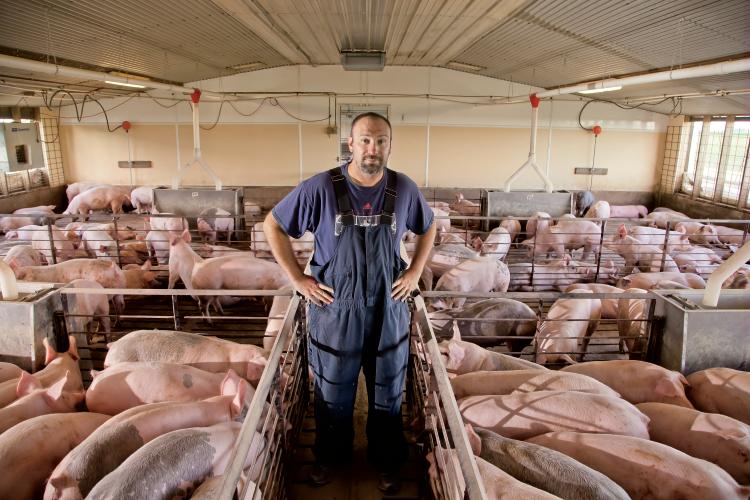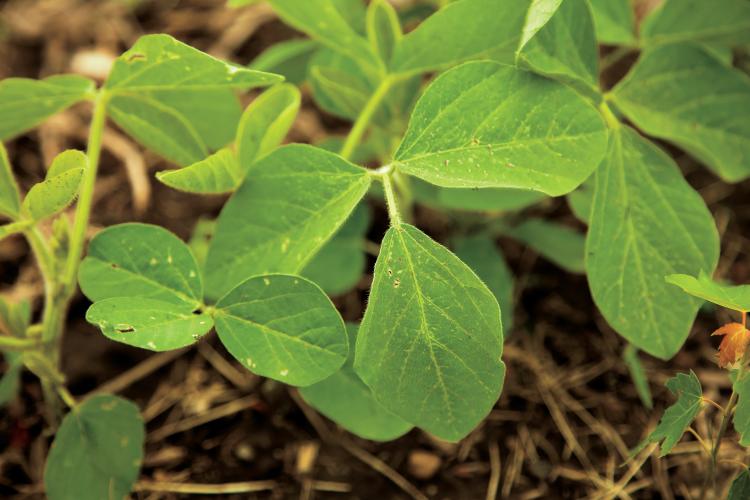Home > Illinois > Illinois Crops & Livestock > Corn, Soybeans and Pork Top Illinois’ Agricultural Commodities
Corn, Soybeans and Pork Top Illinois’ Agricultural Commodities

When it comes to being a prime location for crop production, you might just say Illinois has hit pay dirt. That’s because “the state has some of the finest soil in the world to produce food and fiber,” says Gary Struben, a state soil scientist with the Natural Resources Conservation Service.
“Continental glaciers smoothed the land at a relatively gentle slope and deposited fresh mineral materials that were picked up by the rivers, taken by the wind, and deposited on the area like a blanket,” Struben says. “In addition, the state was covered with prairie grass, which has an extensive root system that deposits additional organic matter into the soil. Organic matter is a key ingredient. It’s the glue that holds the soil together. It provides natural fertility and helps with infiltration of air and water into the soil.”
Add to that a favorable climate and adequate rainfall, and you have a recipe for growing success. “Our deep black prairie soils are hard to beat,” says Struben, noting that they are among the most productive in the world. “The state has 36 million acres of land. Of that, 21 million are prime farmland, and in Illinois 19 million are crop acres. That’s the highest in the U.S. Some states have more prime acreage but not as much of it is in use for crops.”
It’s no surprise then that Illinois is one of the nation’s top producers of corn and soybeans. But what may be a surprise is that easy access to abundant grain also makes the state a top producer of swine, since pork production is one of the largest consumers of corn and soybeans.
High on the Hog
That’s where Dereke Dunkirk comes in. A swine producer in Morrisonville, Dunkirk says living in a state noted for its corn and beans is a definite advantage when raising pigs. “It makes sense to grow the livestock close to the feed,” he says, “especially in a state that has such a rich grain heritage.”
As the fourth leading producer of pork in the country, Illinois hog farmers have their own strong tradition. Dunkirk, and the other 3,400 producers in the state, raise more than 4 million pigs and contribute to an industry that generates nearly $2 billion in economic impact.
Dunkirk and his father, Gary, raise 4,200 of those 4 million pigs on a contract basis for Borgic Farms. Under that arrangement, Borgic delivers 15-pound pigs to the Dunkirks, who care for them for about 24 weeks until they reach market size, which is around 275 pounds.
In return, the Dunkirks receive rent for their barn space and a continuous supply of manure to fertilize the 2,000 acres of corn and soybeans they also grow nearby. By raising the pigs indoors, Dunkirk explains, you can better control disease and you contain the manure in a pit that can be more easily loaded for use on the farm. The climate-controlled environment also keeps the animals more comfortable. “The happier the pigs are, the faster they grow,” he says.
While the Dunkirks previously had their own sows and did all the production, marketing and shipping for their operation, this move to contract finishing in 2011 allowed them to make more efficient use of their labor. It has also allowed them to expand from one barn 10 years ago to two in 2006. In 2012, they will be adding a third barn that will accommodate 2,500 more pigs. And, most importantly, their successful growth has provided the financial wherewithal for another generation of Dunkirks to join the operation.
“My hope is that I’m laying the groundwork for my young son and daughter to return to the farm, should they want to when they get older, just as my father did for me,” Dunkirk says.

Soy from Illinois
Matt Hughes doesn’t raise livestock, but he grows a crop that feeds them. A soybean farmer from southwestern McLean County, Hughes says, “Soybeans are an amazing crop that can provide a good yield even in a drought, fit well in crop rotation practices, and provide an important protein that livestock, and the 7.5 billion people in the world, need.”
With nearly 9.7 million acres of soybeans in Illinois, the state is a national leader in soybean production. Hughes and his wife, Connie, farm 2,600 acres, nearly half of which is soybeans. About 75 percent of the soybeans are grown for seed, and the remaining 25 percent are non-GMO.
“Non-GMO is a specific market demand for those who don’t want modified genetics in the seed,” Hughes says. It requires identity-preserved production, which for producers means additional work in ensuring their purity. But the upside is that non-GMO varieties pay a premium to compensate for the extra work.
Hughes, who has a master’s degree in agricultural economics, enjoys the challenge of those risks and the others associated with farming. He is innovative in his operation and committed to researching and testing new technology. “We had one of the first yield monitors for John Deere, and we employ lots of technology in our operation, such as auto steer equipment, GPS mapping, record keeping, analysis, and soil fertility application,” he says. “Having the right tools gives us the luxury of being able to test new fertilizer management and seed technologies as well as different planting dates and other strategies for improving production.”
New technologies are always there, Hughes says, you just have to be willing to take the risk to try them. “The efficiencies that these and other advanced technologies provide continue to enhance yields. It’s what will take growing soybeans to the next level.”

Maize Pays
Jim Rapp is a third-generation farmer whose operation in central Bureau County and eastern LaSalle County includes a fourth generation – his sons, Nick and Ben. This year, 75 percent of their acreage will be planted in corn, a crop that is grown across almost 12 million acres of Illinois farmland and that the state is known for worldwide as both a source of feed and a source of fuel.
“Ethanol has made a huge difference for Illinois corn producers as well as for the prosperity of rural America,” Rapp says. “As a state, we have so many acres committed to corn, and without ethanol we would have had an overabundance of corn, which leads to lower prices. It’s been a significant change for corn growers.”
As a farmer for more than 40 years, Rapp has seen a lot of change in the industry, from the development of the ethanol market to the advancements in precision farming, herbicides and genetics to changes in tillage strategies.
“These new technologies offer a lot for everybody, and we make use of a lot of it,” Rapp says “We also want to learn and understand how to do spring strip till because we would like to get there 100 percent. You have to keep up with these changes to be successful.”
But at the same time, the worries that kept Rapp awake at night when he was starting out in the 1960s continue to be a challenge today.
“The most difficult things about farming are the same as they’ve always been – weather and the markets,” he says. “That’s what provides the biggest challenges as well as the opportunities. I still haven’t figured out either of them.”



